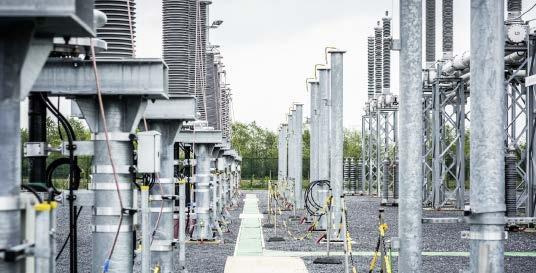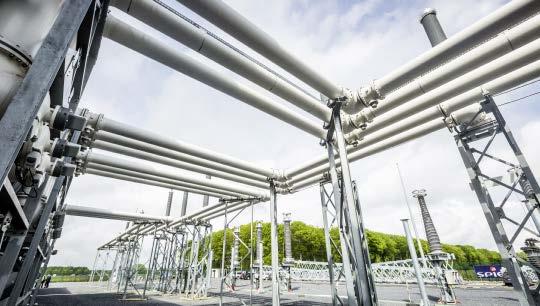
4 minute read
3.2. Hourly electricity market model
3.2 HOURLY MARKET ELECTRICITY MODEL
An electricity market simulator developed by RTE, called ANTARES, is used to perform the electricity market and adequacy simulations. ANTARES calculates the most-economic unit commitment and generation dispatch, i.e. the one that minimises the generation costs while respecting the technical constraints of each generation unit. The dispatchable generation (including thermal & hydro generation, storage facilities and demand side response) and the cross-border market exchanges constitute the decision variables of an optimisation problem, which essentially aims to minimise the total operational costs of the system. In order to simulate the European electricity market, several assumptions and parameters must be defined. These elements are described in Section 2.3.3. Figure 72 gives an overview of the input and output data of the model.
INPUT AND OUTPUT DATA FOR THE MODEL (FIG. 72)
INPUT DATA
— Consumption — Centralised thermal production facilities — Decentralised thermal production facilities — Renewable production — Interconnection capacity between countries — Storage — Demand flexibility
SIMULATIONS
Hourly dispatch optimisation to minimise costs
For 22 countries
MODEL OUTPUT
— Hourly dispatch for all units in each country — Commercial exchanges between countries
— Hourly marginal prices
— Adequacy indicators • LOLE, ENS — Economic indicators • Market welfare, total costs, unit revenues, running hours — Sustainability indicators • Emissions, RES share — Dispatch indicators • Imports/exports, generation per type
The main input data for each country are: — The hourly consumption profiles (including thermosensitivity effect, demand growth, consumption of heat pumps and electric vehicles); — The installed capacity of thermal generation facilities and associated availability parameters or hourly production profiles for distributed generation; — The installed PV, wind and hydroelectric capacity and associated production profiles based on the climate years; — The interconnections or fixed commercial exchange capacities between countries and simultaneous max import capacities (NTC method) . These data are introduced by means of hourly or monthly time series or are established for a whole year. The inputs provided to the tool enable the simulation of the market and determine the ‘future states’ based on a random selection from the associated time series. As described in Section 3.1.3, the climatic data relating to a given variable for a specific year will always be combined with data from the same climatic year for all other variables and applied to all the countries. Based on these inputs, the optimisation problems are solved with an hourly time step and a weekly time-frame, making the assumption of perfect information at this time horizon but assuming that the evolution of load and RES is not known beyond this. Fifty-two weekly optimisation problems are therefore solved in a row for each ‘Monte-Carlo’ year. The optimal dispatch is based on market bids on the marginal costs of each unit [€/MWh]. When this optimum is found, the following output can be analysed: — Locational marginal prices based on market bids (in this study locations are market zones); — Hourly dispatch of all the units; — Hourly commercial exchanges between market zones.
Following the simulations, the output data provided by the model enables a large range of indicators to be determined: — Adequacy indicators (LOLE, ENS); — Economic indicators (welfare, total costs, unit revenues, running hours,...); — Sustainability indicators (emissions, RES shares); — Dispatch indicators (imports/exports, generation per fuel/ technology). A number of modelling assumptions are important to be highlighted to correctly interpret the results: — Hourly simulations of the market are performed considering that all the energy is sold and bought in the day-ahead market. There is no explicit modelling of longer term markets nor shorter time-frame markets (intraday and balancing); — An optimal solution is sought in order to minimise the total costs of operation of the whole simulated system; — Perfect foresight is considered for renewable production, consumption and unit availability. This is not the case in reality, where forecasting deviations and unexpected unit outages are happening. Note that in the modelling approach for each market zone, a part of the capacity is reserved for balancing purposes and cannot be dispatched by the model in order to cope with such events; — A perfect market is assumed (no market power, bidding strategies,...) in the scope of the model; — Pumped storage units, batteries and demand flexibility are dispatched in order to minimise the total operation costs of the system. In reality this could be different as they could be used to net a certain load in a smaller zone or to react to other signals. The modelling approach also assumes that price signals are driving the economic dispatch of those technologies; — Prices calculated in the model are based on the marginal price of each unit; — A single point of efficiency is considered for each thermal unit (no partial load efficiencies are considered): in reality this efficiency depends on the generated power of the unit; — The commercial exchange capacities between all countries, including the CWE area, are modelled through the maximum fixed commercial capacity (NTC – ‘Net Transfer
Capacity’); — The value of lost load used in the model was set to 3000 €/MWh which is currently the price cap used in the day-ahead market. Note that the effective loss of load value is higher; — A curtailment cost is set from 50 to 100 €/MWh to penalise the surplus of energy in the system that cannot be evacuated or stored at a given moment.
How is the Unit Commitment and Economic Dispatch performed? More information available in Annex 7.3.2.







